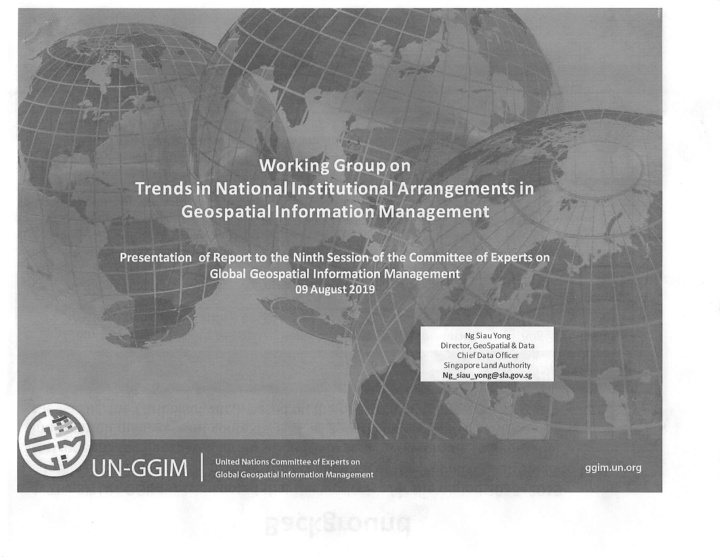



.4^ zyxwvutsrqponmlkjihgfedcbaZYXWVUTSRQPONMLKJIHGFEDCBA \ -■ i.' ..-h Working Group on Trends in National Institutional Arrangements in Geospatial Information Management , f-H Presentation of Report to the Ninth Session of the Committee of Experts on Global Geospatial Information Management 09 August 2019 J. , Ng SiauYong Director, GeoSpatial & Data Chief Data Officer Si nga pore La nd Authority Ng_siau_yong(S)sla.gov.sg -• .t" 'V • v 'S.J v.-^ >• -Sf United Nations Committee of Experts on UN-GGIM ggim.un.org Global Geospatial Information Management
Background 1. The 8'^ UN-GGIM session noted that the work plan for the period 2018-2019 contained one major task, namely, the preparation of the 'Foundationai Guide to NIA Instruments for Geospatial Information Management' according to geospatial information management contexts, such as geographic regions (e.g. Africa, Asia and the Pacific, the Caribbean, etc.), based on the overarching framework for NIA Date of key Key tasks/activities completed S/N tasks/activities Aug 2018 to July 'Foundationai Guide to NIA Instruments for Geospatial Information Management (Asia-Pacific)' based on the Asia-Pacific region 2019 Nov 2018 to June 7 online meetings with NIA-WG members and the UN-GGIM Secretariat 2019 01 April 2019 Update on NIA-WG's activities, including alignment between the Foundationai Guide and Integrated Geospatial Information Framework (IGIF), atthe UN-GGIM Expanded Bureau Meeting in Amsterdam,the Netherlands Discussion and contribution towardsthe alignment between the 18 to 21 June Foundationai Guide and IGIF at the 4th expert consultation and meeting 2019 on the development of the IGlF's Implementation Guide in Kuala Lumpur, Malaysia United Nations Committee of Experts on UN-GGIM ggim.un.org Global Geospatial Information Management
Introduction to the Foundational Guide to NIA Instruments for Geospatial Information Management (Asia-Pacific) ipproach towards Guide . 'Geographic region' identified to be the most suitable, objective, and neutral approach . Asia-Pacific region formed initial focus due to limitations in resources and need for broader participation towards documentation of other regions Main components of the Foundational Guide 1. Introduction a) Overview of the NIA instrumentsand principles. 2. Self-assessment framework a) Self-assessment checklist - assessment tool to help Member States determine the status and level of adoption of the NIA instruments. b) Roadmap of institutional design - helps Member States decide on the implementation approach towards the NIA instruments by consideringthem in combination and connection with one another. 3. Guide to NIA instruments In the Asia-Pacific Region a) Implementation steps and guidelines supported by known practices from the Asia-Pacific region, .^Joreach instrument sa UN-GGIM United Nations Committee of Experts on ggim.un.org Global Geospatial Information Management
How the Foundational Guide & IGIF can help Member States Example: NIA instrument 'Establishment of coordinating functions or entities' 1. Develop a geospatial information management (GIM) strategy Implementation step Implementation step 2. Appoint a Steering Committee a) Develop the Committee from specialised functional committees or Implementation task forces in the early stages of the GIM strategy guidelines considers b) Chair: Cabinet Member, or the Ministry overseeing the GIM strategy; region-specific contexts Co-chair and Secretariat: geospatial-related agencies that could support IGIF Malaysia: The National Land Information System Coordinating Committee was replaced by the implementation Malaysian Geospatial Data Infrastructure National Coordinating Committee, with the Ministry of Natural Resources and Environment as the Chair and Malaysian Centre for Geospatial Data Known practices Infrastructure as the secretariat provides details and examples that could Japan: The Deputy Chief Cabinet Secretariat serves as the chair of the committee for Advancement enhance the IGIF of Utilizing Geospatial Information (AUGI), and the Cabinet Secretariat as the secretariat. 3. Establish a Geospatial Information Coordination Unit and Implementation step specialist working groups 53 United Nations Committee of Experts on UN-GGIM ggim.un.org Globai Geospatial Information Management
Alignment between the Foundational Guide and IGIF Consultation and discussion on the alignment with the Foundational Guide and IGIF conducted among the NIA-WG, UN-GGIM Secretariat and IGIF reference group through: a) Online meetings b) 4th expert consultation and meeting on the development of the IGlF's Implementation Guide held in Kuala Lumpur, Malaysia Main points agreed-upon; a) NIA instruments complemented the IGlF's strategic pathways b) IGIF formed an overarching framework that the Foundational Guide could enhance and deepen c) Incorporating content from the NIA Foundational Guide, such as implementation steps and guidelines, into the major actions of the IGlF's strategic pathways, would be a suitable approach toward aligning the two resources. United Nations Committee of Experts on UN-GGIM ggim.un.org Global Geospatiai Information Management
Next Steps 1. Develop the Foundational Guide further by creating recommendations for other geographic regions, such as Africa, the Americas, Arab States and Europe, based on the approach taken for the Asia-Pacific region 2. Seek more active engagement and participation of Member States, with further assistance from the UN-GGIM Regional Committees to seek contribution and support from their Member States 3. Continue alignment between the Foundational Guide and the IGIF United Nations Committee of Experts on UN-GGIM ggim.un.org Global Geospatial Information Management
Points for Discussion The Committee of Experts is invited to: a) Take note of the report and the work carried out by the Working Group in developing the 'Foundational Guide to National Institutional Arrangement Instruments for Geospatial Information Management (Asia-Pacific)', provided as a background document to this present report; b) Express its views on the Working Group's efforts in aligning the Guide with the Integrated Geospatial Information Framework and supporting the preparation of the Implementation Guide; and c) Provide guidance on the 'Foundational Guide to National Institutional Arrangement Instruments for Geospatial Information Management (Asia-Pacific)' and considerations for capturing other geographic regions in a similar manner. United Nations Committee of Experts on SyUH-GGM ggim.un.org Giobai Geospatiai information Management
Recommend
More recommend